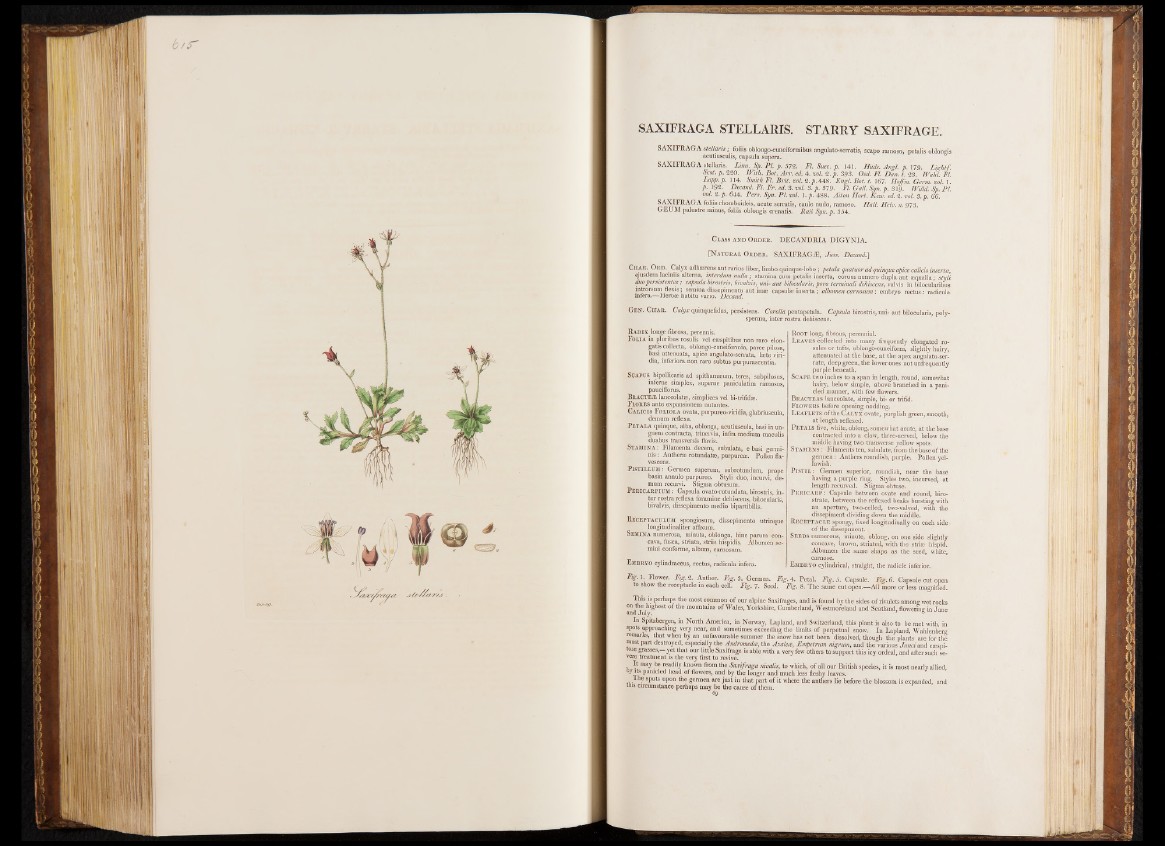
tT ff !»bïr <i 'TW
SAXIFRAGA STELLARIS. STARRY SAXIFRAGE.
SAXIFRAGA stellaris ; foliis oblongocuneiforraibus angulato-serratis, scapo raraoso, petalis oblongis
acutiusculis, capsula supera.
SAXIFRAGA stellaris. Linn. Sp. PI. p. 572. Fl. Suec. p . 141. Huds. Angl. p. 179. Lightf.
Scot. p. 220. With. Bot. Arr. ed. 4 .'vol. 2 .p . 393. Oed. Fl. Dan. t. 23. Wahl. Fl.
Lapp. p. 114. Smith Fl. Brit. vol. 2.p . 448. Engl. Bot. t. 167. Hoffm. Germ. vol. 1.
p . 192. Decand. Fl. Fr. ed. 3. vol. 3. p. 379. Fl. Gall. Syn. p. 319. Willd. Sp. PI.
vol. 2. p. 644. Pers. Syn. PI. vol. 1. p. 488. Aiton Hort. Kew. ed. 2 . vol. 3. p. 66.
SAXIFRAGA foliis rhomboideis, acute serratis, caule nudo, ramoso. Hall. Helv. n. 973.
GEUM palustre minus, foliis oblongis crenatis. Raii Syn. p. 354.
Class and Order. DECANDRIA DIGYNIA.
[Natural Order. SAXIFRAGÆ, Juss. Decand.']
Char. Ord. Calyx adhærens aut rarius liber, limbo quinque-lobo ; petala quatuor ad quinque apice calicis inserta,
ejusdem lacinns alterna, interdum nulla ; stamina cum petalis inserta, eorum numéro dupla aut æqualia; styli
duo persist entes ; capsula birostris, bivalvis, uni- aut bilocularis, poro terminali dehiscens, valvis in bilocularibus
introrsum flexis ; semina dissepimento aut imæ capsul® inserta ; albumen carnosum ; embryo rectus: radicula
inféra.— Herbæ habitu vario. Decand.
Gen.- Char. Calyx quinquefidus, persistens. Corolla pentapetala. Capsula birostris, u
sperma, inter rostra dehiscens.
- aut bilocularis, poly-
Radix longe fibrosa, perennis.
Folia in pluribus rosulis vel csespitibus non raro elongates
collecta, oblongo-cuneiformia, parce pilosa,
basi attenuate, apice angulato-serrata, lsete viri-
dia, inferiora non raro subtus purpurascentia.
Scapus bipollicaris ad spitham®um, teres, subpilosus,
inferne simplex, superne paniculatim ramosus,
pauciflorus.
Bragteje lanceolat®, simplices vel bi-trifid®.
Flores ante expansionem nutantes.
Calicis Foliola ovata, purpureo-viridia, glabriuscula,
demum refiexa.
Petala quinque, alba, oblonga, acutiuscula, basi in un-
guem contracta, trinervia, infra medium maculis
duabus transversis flavis.
Stamina : Filamenta decern, subulata, e basi germi-.
nis: Anther® rotundat®, purpure®. Pollen fla-
vescens.
Pistillum: Germen superum, subrotundum, prope
basin annulo purpureo. Styli duo, incurvi, demum
recurvi. Stigma obtusum.
Pericarpium : Capsula ovato-rotundata, birostris, inter
rostra refiexa foramine dehiscens, bilocularis,
bivalvis, dissepimento medio bipartibilis.
Receptaculum spongiosum, dissepimento utrinque
longitudinaliter affixum.
Semina numerosa, minuta, oblonga, hinc parum con-
cava, fusca, striata, striis hispidis. Albumen se-
mini conforme, album, carnosum.
Root long, fibrous, perennial.
Leaves collected into many frequently elongated ro-
sules or tufts, oblongo-cuneiform, slightly hairy,
attenuated at the base, at the apex angulato-ser-
rate, deep green, the lower ones not unfrequently
purple beneath.
Scape two inches to a span in length, round, somewhat
hairy, below simple, above branched in a pani-
cled manner, with few flowers.
Bracteas lanceolate, simple, bi- or trifid.
Flowers before opening nodding. •
Leaflets of the Calyx ovate, purplish green, smooth,
at length reflexed.
Petals five, white, oblong, somewhat acute, at the base
contracted into a claw, three-nerved, below the
middle having two transverse yellow spots.
Stamens : Filaments ten, subulate, from the base of the
germen: Anthers roundish, purple. Pollen yellowish.
Pist il : Germen superior, roundish, near the base
having a purple ring. Styles two, incurved, at
length recurved. Stigma obtuse.
Pericarp: Capsule between ovate and round, biro-
strate, between the reflexed beaks bursting with
an aperture, two-celled, two-valved, with the
dissepiment dividing down the middle.
Receptacle spongy, fixed longitudinally on each side-
of the dissepiment.
Seeds numerous, minute, oblong, on one side slightly
concave, brown, striated, with the striae hispid.
Albumen the same shape as the seed, white,
Embryo cylindraceus, rectus, radicula infera.
Fig. 1. Flower. Mg. 2. Anther. Fig. 3. Germen. Fif
to show the receptacle in each cell. Fig. 7 . Seed.
This is perhaps the most common o f our alpine Saxifrages, and is found by the sides of rivulets among wet rocks
on the highest of the mountains of Wales, Yorkshire, Cumberland, Westmoreland and Scotland, flowerms in June
and July. • ®
In Spitzbergen, in North America, in^ Norway, Lapland, and Switzerland, this plant is also to be met with, in
spots approaching very near, and sometimes exceeding the limits of perpetual snow. In Lapland, Wahlenbero-
remarks, that when by an unfavourable summer the snow has riot been dissolved, though the plants are for the
most part destroyed, especially the Andromeda, the Azalea, Empetrum nigrum, and the various Junci and c®spi-
ose grasses,—yet that our little Saxifrage is able with a very few others to support this icy ordeal, and after such severe
Embryo cylindrical, straight, the radicle inferior.
4. Petal. Fig. 5. Capsule. Fig. 6. Capsule cut open
Fig. 8. The same cut open.— All more or less magnified.
treatment is the very first to revive.
It may be readily known from the Saxifraga nivalis, to which, of all our British species, it is most nearly allied,
Jpamc l e d head of flowers, and by the longer and much less fleshy leaves.
I he spots upon the germen are just in that part of it where the anthers lie before the blossom is expanded, and
uus circumstance perhaps may be the cause of them.
!